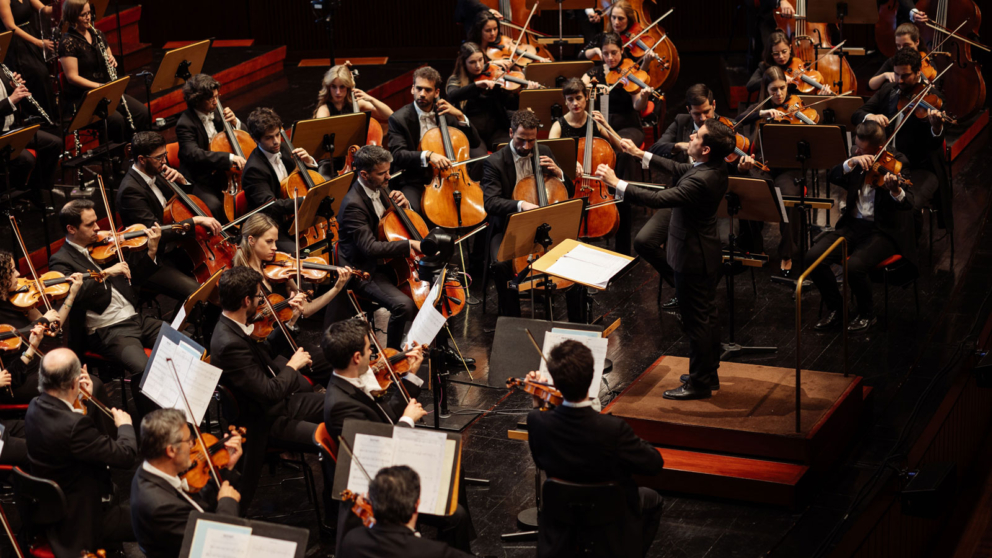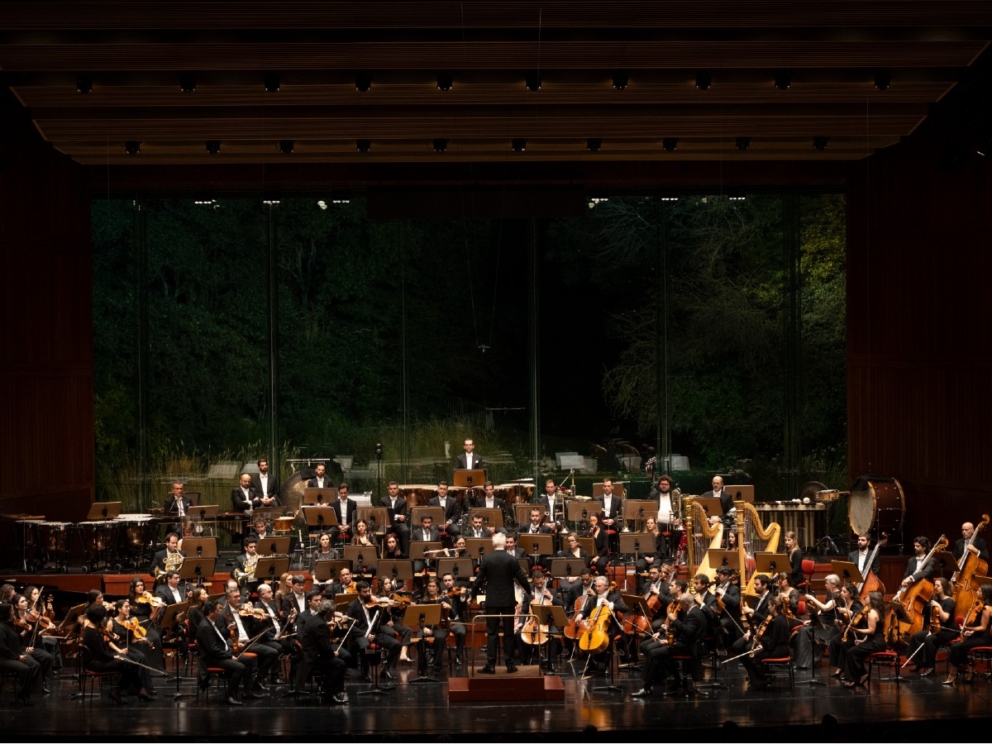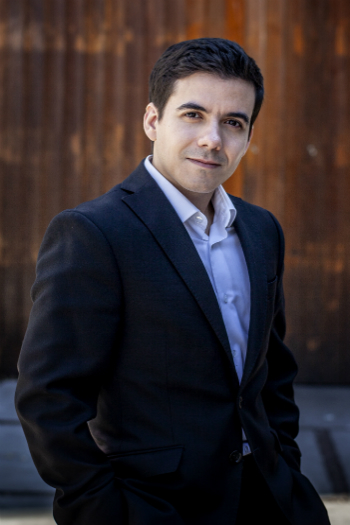Nuno da Rocha: Restart
Orquestra Gulbenkian / Nuno Coelho

Restart resultou de uma encomenda da Fundação Gulbenkian, destinada a abrir o programa inaugural da Orquestra Gulbenkian na temporada 2015-16, com a maestrina Joana Carneiro a dirigir uma formação que juntou Orquestra Gulbenkian e Estágio Gulbenkian para Orquestra.
A peça está instrumentada para uma orquestra “romântica” convencional (com as madeiras a 3, sendo o 3.º instrumento sempre um alargador da extensão e do timbre, respetivamente, do agudo para o grave: flautim, corne-inglês, clarinete-baixo e contrafagote; mais trompas a 4, e trompetes e trombones a 3), mas enquadrada com um instrumentário de percussão alargado, além de enriquecido com recursos menos convencionais, casos da melódica, da harmónica e do (assim designado) “junk kit”: um instrumento compósito, feito de objetos do quotidiano, dispostos qual teclado, do grave ao agudo.
Particularmente interessante nesta obra é a contínua alternância que exibe entre secções notadas com altura definida e secções notadas com altura indefinida, algo muito familiar no naipe de percussão (por via dos próprios instrumentos), mas que se vê aqui alargado a todos os naipes da orquestra, de tal modo que se configura como princípio constitutivo da peça como um todo. Nuno da Rocha prescreve aos executantes apenas a “região média” da extensão dos respetivos instrumentos, cabendo aos músicos definir o “onde” (que pode variar a cada recorrência) e, a partir daí, definir notas mais agudas e notas mais graves (de acordo com a notação nas suas partes). Este constante vaivém entre notação fixa e notação aberta, esta interação, causam a perceção de constante “restart”, como um rosto em permanente reformulação. Outro recurso original é o flexatone (usado por: instrumentistas de cordas, exceto contrabaixos; trompas e trompetes); bem como requerer dos músicos (cordas) que murmurem, dobrando a nota que executam ou sem apoio.
Embora um contínuo, divisam-se em Restart três grandes secções: a 1.ª começa poderosa e imponente e termina com uma melodia quase pós-romântica das cordas expostas; a 2.ª individualiza-se pela sua pesquisa tímbrica e organização mais caleidoscópica; e a 3.ª, por uma textura eufónica de coral muito lento das cordas (com as vozes a dobrar), na qual mais tarde os outros instrumentos (ouvem-se rememorações de motivos anteriores) se virão (dir-se-ia, quase relutantemente) a inscrever, até que tudo por fim se esfuma num sopro pianissimo das vozes.
Intérpretes
- Maestro
-

Gulbenkian Orchestra
In 1962, the Calouste Gulbenkian Foundation decided to establish a permanent orchestral ensemble. Originally with only twelve musicians (strings and continuo) it was named “Orquestra de Câmara Gulbenkian”. This collective was successively enlarged and today the “Orquestra Gulbenkian” (the name it has adopted since 1971) has a permanent body of sixty instrumentalists, a number that can be expanded depending on the repertoire.
This structure allows the Gulbenkian Orchestra to interpret works from the Baroque and Classical periods, a significant part of 19th century orchestral literature and much of the music of the 20th century, including works belonging to the current repertoire of the traditional symphonic orchestras. In each season, the orchestra performs on a regular series of concerts at the Gulbenkian Grand Auditorium in Lisbon, where it has had the opportunity of working together with some of leading names of the world of music (conductors and soloists). It has also performed on numerous locations all over Portugal, in an effort to decentralize music and culture.
The orchestra has been constantly expanding its activities in the international level, performing in Europe, Asia Africa, and the Americas. In the recording field, Orquestra Gulbenkian is associated to labels as Philips, Deutsche Grammophon, Hyperion, Teldec, Erato, Adès, Nimbus, Lyrinx, Naïve and Pentatone, among others, and this activity was recognized with several international prizes.
-

Nuno Coelho
Guest Conductor
The 2022/23 season sees Nuno Coelho commence his Chief Conductor and Artistic Directorship of the Orquesta Sinfónica del Principado de Asturias. He also begins his fifth year as Guest Conductor of the Gulbenkian Orchestra with a production of José Saramago’s reimagining of Mozart’s Don Giovanni to mark the writer’s centenary. Highlights elsewhere include debuts with the Royal Concertgebouw Orchestra, Tampere Philharmonic and Sinfonieorchester St Gallen; returns to Antwerp Symphony and Orquesta Sinfónica de Tenerife; and a tour with the Joven Orquesta Nacional de España.
Last season saw Nuno debut with the Helsinki Philharmonic, Dresden Philharmonie, Staatsorchester Hannover, Orchestre Philharmonique du Luxembourg, Gavle Symphony, Malmö Symphony, Residentie Orkest, Orchestre philharmonique de Strasbourg and Orchestre National de Lille; and continue his relationships with the Orquesta Sinfonica de Galicia and Orquestra Simfónica de Barcelona. In March 2022 he conducted a semi-staged Così fan tutte at the Gulbenkian, adding to theatre credits which include productions of La traviata, Cavalleria rusticana, Rusalka, Das Tagebuch der Anne Frank and Seven Deadly Sins.
Nuno won First Prize at the 2017 Cadaqués International Conducting Competition and has since gone on to conduct the Royal Liverpool Philharmonic, BBC Philharmonic, Symphoniker Hamburg, Orquesta Sinfónica de Castilla y León, Noord Nederlands Orkest and Orchestra Teatro Regio Torino. He was a Los Angeles Philharmonic Dudamel Fellow between 2018-19 and stepped in for Bernard Haitink that same season to make his debut with the Symphonieorchester des Bayerischen Rundfunks.
Born in Porto, Nuno studied conducting at the Zürich University of the Arts with Johannes Schlaefli and won the Neeme Järvi Prize at the Gstaad Menuhin Festival. In 2015 he was admitted into the German Music Council’s Dirigentenforum and for the following two years he was both a Tanglewood Conducting Fellow and Assistant Conductor of the Netherlands Philharmonic. Literature and tennis occupy his time off-podium.
Programa
Nuno da Rocha
Restart
